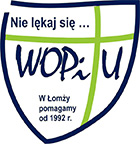Zakład opiekuńczo-leczniczy
Z przyjemnością informujemy, że w ramach umowy w NFZ
od 01.07.2022 r. funkcjonuje w strukturach WOPiTU
W ramach, którego działa:
Zakład opiekuńczo-leczniczy o profilu ogólnym – 26 łóżek
Zakład opiekuńczo-leczniczy dla Pacjentów Wentylowanych Mechanicznie – 4 łóżka
Świadczenia udzielane są w zakresie:
- prowadzenia pełnej opieki pielęgnacyjnej i opiekuńczej,
- prowadzenia opieki lekarskiej w niezbędnym zakresie,
- prowadzenia leczenia farmakologicznego i dietetycznego odpowiedniego do stanu zdrowia pacjenta,
- wykonywania zabiegów fizjoterapeutycznych i rehabilitacyjnych,
- prowadzenia psychoterapii
- prowadzenia terapii zajęciowej
- prowadzenia terapii logopedycznej w niezbędnym zakresie
Jedynie prawdziwy człowiek zauważy potrzeby innego człowieka.
Jedynie człowiek wielkiego serca wyciągnie doń pomocną dłoń.

Usługi zdrowotne w opisanym wyżej zakresie wykonuje wykwalifikowany personel medyczny:
- lekarze specjaliści
- pielęgniarki posiadające dodatkowe kwalifikacje mające zastosowanie w specjalistycznej opiece długoterminowej
- opiekunowie medyczni
- fizjoterapeuci
- psycholog
- logopeda
- terapeuta zajęciowy
Opłaty za pobyt w Zakładzie opiekuńczo-leczniczym
Opłatę za pobyt w Zakładzie ustala się w wysokości odpowiadającej 250% najniższej emerytury, z tym że opłata nie może być wyższa niż kwota odpowiadająca 70% miesięcznego dochodu pacjenta w rozumieniu przepisów o pomocy społecznej (art. 18 ustawy z dnia 27 sierpnia 2004 r. – o świadczeniach opieki zdrowotnej finansowanych ze środków publicznych).
Dbamy, aby każdy korzystający z naszych usług był zadowolony z warunków pobytu oraz ze sposobu świadczenia całościowej opieki.
Dla kogo ZOL?
ZOL zapewnia całodobową opiekę pacjentom z ukończonym diagnozowaniem i udokumentowanym procesem leczenia szpitalnego, którzy nie wymagają hospitalizacji i stałego nadzoru lekarskiego, ale nie są samodzielni ze względu na stan zdrowia. Ośrodek sprawuje opiekę medyczną całodobowo. Głównie obejmuje opieką pacjentów przewlekle chorych, z niepełnosprawnością lub po ciężkiej chorobie albo zabiegu operacyjnym. Długość pobytu w zakładzie uzależniona jest od stanu zdrowia i oceny w skali Barthel.
Do Zakładu Opiekuńczo-Leczniczego mogą trafić tyko osoby ubezpieczone lub mające inne prawo do korzystania ze świadczeń.
Do zakładu opiekuńczego nie przyjmuje się osób wymagających całodobowej opieki lekarskiej lub hospitalizacji, uzależnionych, z zaawansowaną chorobą nowotworową lub psychiczną, z chorobą zakaźną.
W dniu przyjęcia dokonuje się w zakładzie ocenę stanu zdrowia pacjenta wg zmodyfikowanej skali Barthel (jak w karcie kwalifikacyjnej).
Jeżeli ocena przekracza 40 pkt pacjent nie może być przyjęty do zakładu.
W dniu przyjęcia wskazana obecność opiekuna oraz dowód tożsamości pacjenta do wglądu.
Część medyczna
Wniosek o wydanie skierowania do zakładu opiekuńczo-leczniczego/zakładu pielęgnacyjno-opiekuńczego
Wywiad pielęgniarski i zaświadczenie lekarskie
Skierowanie do zakładu opiekuńczo-leczniczego/zakładu pielęgnacyjno-opiekuńczego
Karta oceny świadczeniobiorcy kierowanego do zakładu opiekuńczego (ocena według Skali Barthel)
Dotychczasowa dokumentacja medyczna (kserokopia)
W przypadku trwającej hospitalizacji – wstępna epikryza lekarska
W przypadku pacjenta zakwalifikowanego do żywienia dojelitowego – karta kwalifikacji dorosłych do leczenia żywieniowego oraz kwalifikacja do leczenia dietą przemysłową poprzez sondę/peg powyżej 30dni, skala GLASGOW
W przypadku pacjenta zakwalifikowanego do wentylacji mechanicznej – karta kwalifikacji pacjenta do przewlekłej wentylacji w warunkach stacjonarnych
W przypadku pacjentów przyjmowanych z domu: Wyniki badań laboratoryjnych wykonanych w okresie od 1- 3 miesięcy ( morfologia, CRP, badanie ogólne moczu, Aspat, Alat, bilirubina, jonogram, glukoza, kreatynina i mocznik we krwi)
Część administracyjna
- Legitymacja Emeryta / Rencisty (kserokopia)
- Decyzja ZUS/KRUS o wysokości świadczeń emerytalno-rentowych (w przypadku emerytów / rencistów) lub ksero decyzji o przyznaniu zasiłku stałego z MOPS; jeżeli pacjent jest osobą pracującą – zaświadczenie z miejsca pracy o wysokości dochodów; w przypadku własnej działalności zaświadczenie ZUS.
- Orzeczenie Powiatowego Zespołu ds. orzekania o stopniu niepełnosprawności
- Postanowienie sądu o ustaleniu opiekuna prawnego w przypadku pacjenta ubezwłasnowolnionego
- Zgoda sądu o umieszczenie w ZOL w przypadku pacjenta nieprzytomnego wniosek do pobrania
dostarczamy ksero ww. dokumentów – oryginały do wglądu

